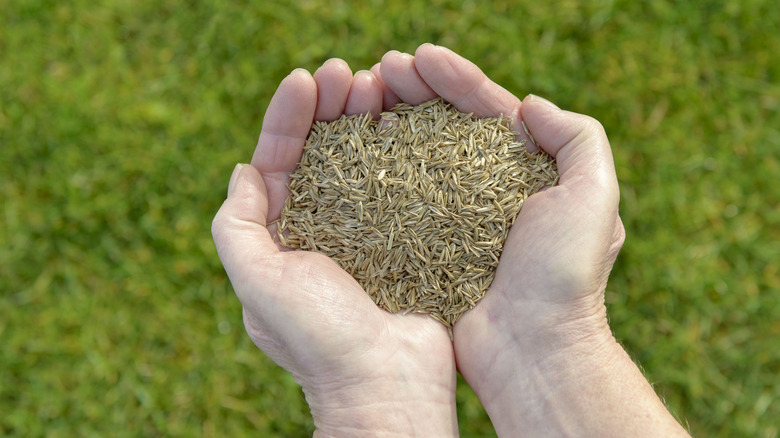Lawn Seeding Techniques: Which Method Is Best For Your Yard?
We may receive a commission on purchases made from links.
Aeration seeding, slit seeding, overseeding, power seeding — these, among others, are terms used to describe techniques for planting grass seeds. But which of these is the most suitable and effective in your situation? If you're a novice gardener, all the jargon can sound overwhelming, and the definitions may seem to overlap. Well, in simple terms, the most suitable seeding method is one that aerates the soil, ensures the best soil-to-seed contact, and gets rid of pesky weeds. In other words, simply broadcasting the weeds on top of the soil is not an efficient way to go.
Common methods for ensuring that the soil is prepared to receive seeds involve aeration or tilling. With these tasks out of the way, you can seed by hand, with a lawn spreader, or by hiring a landscaping company to power seed the turf. However, there are a few nuances to the process that hinge on whether you're seeding on bare soil or overseeding. Below, we explain the different seeding methods and techniques in detail, and give you a few tips for ensuring the lawn's healthy growth.
Seeding techniques to use on bare soil and for overseeding
Regardless of the technique used to broadcast the seeds, there are two, broad categories of lawn seeding: bare soil seeding and overseeding. As the name suggests, bare soil seeding refers to the practice of planting seeds in a location on which no grass presently grows. For example, if you're seeding in a brand-new location or repairing patches on your lawn, you're bare soil seeding. For best results while bare soil seeding, you should at least prepare the substrate before you broadcast the seeds. Crucially, you should till the soil. Tilling uproots dead old grass, weed, and debris, aerates the soil, and helps the seeds germinate by improving soil-to-seed contact. If you're unable to find a rototiller, or are working on smaller bald patches, you can aerate the soil using a simple aerator you can purchase for around $33 from The Home Depot.
Overseeding is meant to thicken and rejuvenate an existing lawn, allowing you to add grass to areas that are thinning out, or introduce a new grass variety if the existing one isn't thriving under the current conditions. When overseeding, aerating sparsely growing patches helps improve germination. Although it may be tempting to overseed without preparing the soil first, taking this shortcut is bound to leave you with dismal germination rates (i.e. you'll waste your time and seeds).
Tips and tricks to know before you seed the lawn
Even if you're using appropriate techniques, there are some tips that will help you grow a lush and healthy lawn. Firstly, you must be sure to seed the turf at the right time of year. When seeding coincides with the grass variety's peak growing time, you'll end up with strong grass that germinates and grows quickly. If you're in the northern half of the U.S. and are using cool-season grasses, the best time to seed is in the early fall. The moderate soil and air temperatures at this time of year are conducive to germination and growth for varieties like Kentucky bluegrass, fescue, or perennial rye. On the other hand, the warm-season grasses that beautify the nation's southern lawns grow their best when you plant them just as spring transitions to summer. At this time of year, the soil and air temperatures are warm enough and there's usually abundant rainfall to aid germination in varieties like Bermudagrass and Zoysia.
Fertilizing the substrate before planting can also aid in growth. Before you fertilize, though, you need to take a soil test and determine which nutrients are missing — don't skip this step or you'll end up with a nutritional imbalance in the soil. If you've never done this before, learn how to check the health of your soil with a DIY test. Dethatching the soil may be another necessary step before you seed, especially if the thatch layer is over ½-inch thick.


